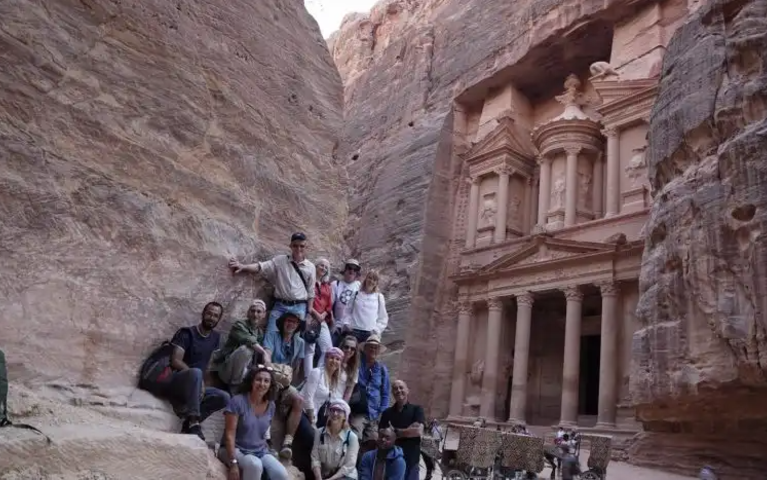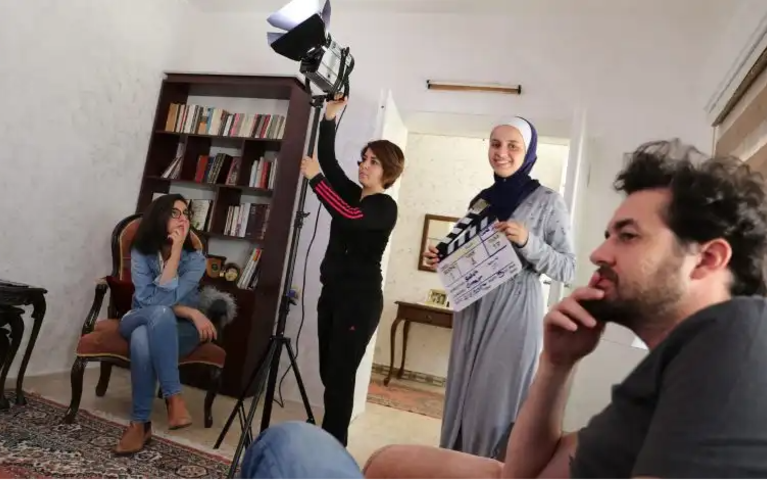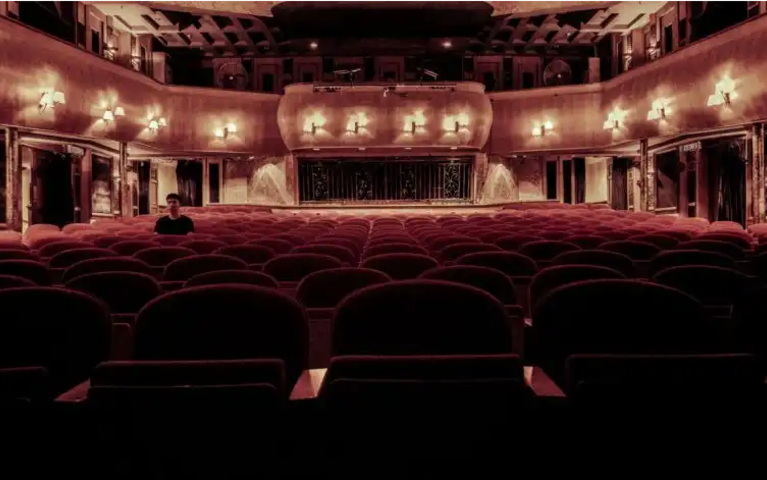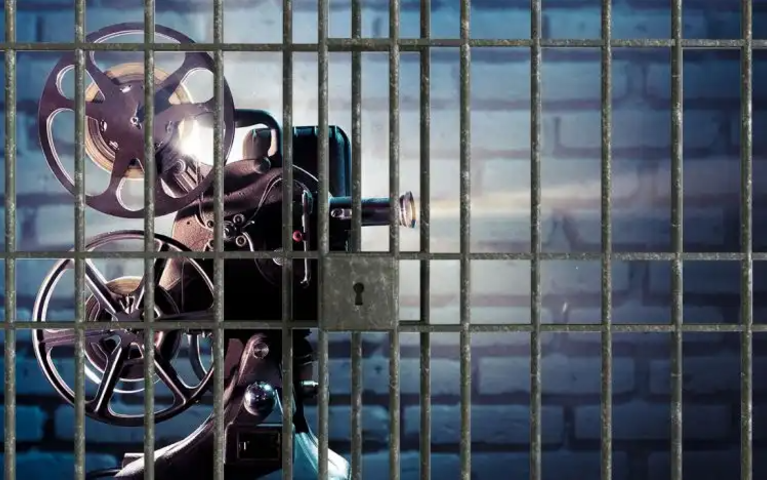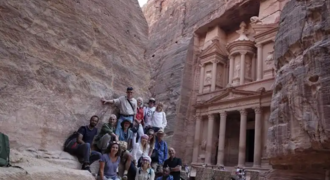Made in Jordan: How to Influence Movie Magic for Generations

No doubt Jordan offers phenomenal settings for many filmmakers everywhere, many of whom choosing Jordan as a filming location since the Royal Film Commission – Jordan (RFC) promoted the Kingdom’s shores, mountains, forests, and deserts as a prime real estate for filmmaking. While many film buffs might recognise the films in this list, many would find the versatility of Jordan’s domain in cinematic catering to be astonishing. First things first, the highly awaited…
The quintessential 1965 science-fiction novel by American author Frank Herbert is considered one of the most influential sci-fi epics in contemporary literary and cinematic history. “Dune”, to put it mildly, is widely influential, inspiring numerous books, television series and most importantly, the entire Star Wars series. There were numerous attempts at adapting it into the big screen, most notably Alejandro Jodorowsky’s unsuccessful attempt in the mid-1970s, which was so packed with details that it inspired an award-winning documentary in 2013.
The premise of the film is set on Arrakis, described as an inhospitable fictional planet. Director Denis Villeneuve insisted that the film should avoid filming on sound-stages as much as possible and thus opted for using the Wadi Rum desert of southern Jordan as the setting for Arrakis. Dune is scheduled for release in November 2020. This was not the first film that Denis Villeneuve filmed in Jordan, but more on that later. And while we’re on Sci-Fi…
Star Wars: Episode IX – The Rise of Skywalker (2019)
Albeit being one of the most divisive films in the series, it was released in 2019 to a massive financial success, grossing over one billion USD worldwide. Being the third instalment of the sequel trilogy and the ninth and final film of the “Skywalker Saga”, the expectations were high and the need for the perfect production sets was immeasurable.
The series is known for its loyal and dedicated fan-base who are more than willing to travel the world to see its premiere, let alone witness its production. Prior to this film, another instalment in the anthology, Rogue One: A Star Wars Story (2016) was partially filmed in Southern Jordan, so when rumours started spreading around regarding another shoot in Wadi Rum, the fans were eager to know. The theories started piling up, with many fans expecting that Episode IX will have a flashback scene to Jedha, the fictional location depicted in Rogue One, and the rumours started to merge into hypotheses when Oscar Isaac’s wife posted that she was in rural Jordan on her Instagram, and the hypotheses turned into theories when John Boyega was spotted in a club in Amman.
The question on everyone’s mind was why the crew returned to Jordan, and specifically the southern valleys and the largely uninhabited deserts of Wadi Rum. George Lucas shot the Tatooine scenes from Star Wars: A New Hope (1977) in southern Tunisia. But for The Last Skywalker, it was Wadi Rum. The crew managed to build miles of road in the desert and set up a small town populated by the cast, extras and crew. Not only did the production hire 250 Jordanian extras across every department including cinematography, costume and creature design, special effects and stunts, the Jordanian Armed Forces got involved. The film benefitted from the Jordan Film Incentive Programme, which provided cash rebate on expenses in the Kingdom. Star Wars: Episode IX premiered in Amman in December 2019 and the series’ biggest fan club, the 501st Legion, flew in from Los Angeles to be there. I was also there but I wasn’t as glamorous. Speaking of stars…
People have been writing science fiction about Mars for the last 200 years, and the more time passed, the more our collective curiosity has grown. Ridley Scott scoured this planet looking for the red one, and like previous Mars-themed films such as Mission to Mars (2000), Red Planet (2000) and The Last Days on Mars (2013), he chose Wadi Rum for the setting of his Oscar-nominated film.
Every external scene of The Martian was filmed in Wadi Rum for over eight days in March 2015. A special Mars Rover model was built for the film; the cast and team of the film presented said vehicle as a gift in return for the hospitality and the aid of 134 Jordanians that have been involved on set. The rover is now exhibited at the Royal Automobile Museum in Amman, which holds a memorable collection of many historical vehicles and film props ranging from the Tron (1982) to authentic World War I tanks, which brings us to…
The Jordanian period drama by the Jordanian filmmaker Naji Abu Nowar tells the story of a young tribal boy named Theeb, facing the harsh realities of Transjordan during World War I in the wake of the Great Arab Revolt. The film premiered in the 71st Venice International Film Festival, . Later it was nominated for the Best Foreign Language Film at the 88th Academy Awards, and Best Film Not in the English Language in the 69th British Academy Film Awards; the first Jordanian film to ever either let alone both. Best Foreign Language Film nomination at 88th Academy Awards, nomination for Best film not in the English language, and the BAFTA Award for Outstanding Debut by a British Writer, Director or Producer at the 69th British Academy Film Awards.“Theeb” is the first Jordanian film to receive an Oscar nomination.
The Jordanian production team, as well as the 20% international staff, that was involved in the filming process had to dodge tourists across the terrain of Wadi Rum as well as violent storms in Wadi Araba in the South West of the Kingdom and again in Dab’ah Palace, south east of Amman. Wadi Rum is a busy place for filming, and many filmmakers avoid the urban landscapes of the capital Amman, but our following film did not…
This French-Canadian war drama was directed by Denis Villeneuve, who returned to Jordan for Dune (2021) ten years later. This film is an adaptation of Wajdi Mouawad’s play of the same name concerning Canadian siblings, who travel to their mother’s unnamed native country to uncover her hidden past and secrets buried by a civil war. In 2011, “Incendies” (or “Scorched” as it is known in the English-speaking provinces of Canada) was nominated for the Academy Award for Best Foreign Language Film.
Central Amman, especially the districts of Jabal Amman and the old downtown played an essential role in mimicking the maybe-Beirut feel that the film has been attempting to portray (the film never stated the city’s name but if you’ve spent more than 15 minutes in Amman you’d know immediately). And keen viewers will know that filming took place right around the corner from the Royal Film Commission’s (RFC) office off Rainbow Street. The production used a number of extras and crew members from Jordan, Lebanon, and Iraq in the filming process. Which reminds me…
This war drama follows the story of an explosion disposal team in 2004 Baghdad. The Hurt Locker was predominantly filmed in various parts of Amman over nine weeks, and after a long and arduous scouting effort for finding a safe yet authentic location by the director Kathryn Bigelow. It was nominated for nine Academy Awards and won six, including Best Picture and Best Director. And to this day, it remains the only Best Picture winner to have been directed by a woman and the second film to be filmed in Jordan to win Best Picture, as well.
Over 150 actors and crew members from Jordan, including Iraqi refugees, were involved in the production. At first, Kathryn Bigelow stated that she wanted to film in Iraq, but the production security team could not guarantee anyone’s safety. East Amman, Madaba and military bases provided a suitable and safe alternative. The cast will talk about their adventures during production in almost every interview, but that wasn’t the most adventurous film by any means to be filmed in Jordan, that title would probably go to…
Indian Jones and the Last Crusade (1989)
The third instalment of the Indiana Jones original trilogy came as an apology to the disappointment that was Indiana Jones and the Temple of Doom (1984), which, at the time, was considered a weaker and a more offensive entry (India banned the film at release due to the poor depiction of Indian culture). The final film was meant to be bigger, more inclusive, more adventurous and aimed to tackle as many places as humanly possible in one feature film. Steven Spielberg after all takes trilogies seriously.
The final act of the film takes place in Jordan, and filming moved to the ancient city of Petra, where its most recognizable landmark, The Treasury, stood in for the Temple of the Sun. Filming took place in Jordan 14 years before the RFC was founded and thus the management and support services to international productions usually offered by the RFC were not an option. Instead, the cast and crew found full support from the Royal Family. Spielberg stated that he was driven to set by Queen Noor numerous times; furthermore, the four horses seen at the final scene belonged to the late King Hussein of Jordan. I’m currently waiting for the apology for Indiana Jones and the Kingdom of the Crystal Skull (2008), maybe a masterpiece fifth instalment that doesn’t have CGI aliens this time? After all our next and final entry to this list is considered one of the best films ever made and not a frame of CGI was involved.
The film is widely regarded as one of the greatest and most influential films ever made. Lawrence of Arabia is considered an actual miracle of filmmaking and its visual style inspired several notable filmmakers such as Steven Spielberg, Denis Villeneuve and Ridley Scott, all of whom filmed in Jordan at one point or another.
The film was originally meant to be filmed entirely in Jordan, and the late King Hussein was highly supportive in providing logistical assistance, location scouting, transportation, as well as extras. But, the interior scenes were shot in Spain. The dream-like scenes of the desert were shot in Wadi Rum’s endless red expanse as well as Mount Tubeiq. The vivid mixture of red sand and black basalt captures the essence of the film to this day. The famous rock formations, better known as the Seven Pillars of Wisdom, were the title of the real Lawrence’s biopic on which this film is based.
Jordan continues to be a great location for filming numerous films from across the world. The previous list was my personal favourite but you can find a full list of every film that was shot in Jordan by visiting the Hall of Films (I can almost guarantee you’ll be surprised by some of them). Furthermore, you can actually watch many of these films by visiting the Film House, which has an extensive film library in a gorgeous 1920s illa. Tell them Rick sent you!
*Rick Hindi was the Communications Coordinator of the Amman International Film Festival (AIFF) in its inaugural edition; he has a passion for films, international relations, linguistics and anthropology.

